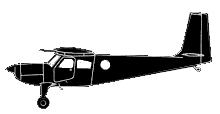
ASN Wikibase Occurrence # 201948
This information is added by users of ASN. Neither ASN nor the Flight Safety Foundation are responsible for the completeness or correctness of this information.
If you feel this information is incomplete or incorrect, you can submit corrected information.
| Date: | Friday 26 February 1999 |
| Time: | 12:57 LT |
| Type: |  Helio H-800 Courier |
| Owner/operator: | Helio Enterprises |
| Registration: | N666X |
| MSN: | H 22 |
| Total airframe hrs: | 14 hours |
| Engine model: | WALTER M 601 D-8 |
| Fatalities: | Fatalities: 0 / Occupants: 1 |
| Aircraft damage: | Substantial |
| Category: | Accident |
| Location: | Prescott, AZ -
 United States of America United States of America
|
| Phase: | Landing |
| Nature: | Unknown |
| Departure airport: | (KPRC) |
| Investigating agency: | NTSB |
| Confidence Rating: |
The airplane sustained a hard landing after the propeller went into an uncommanded reverse pitch range on final approach. This was the first flight with this engine installed. After several successful normal approaches and landings flown at 70 knots, the pilot decided to make a more aggressive STOL (short takeoff and landing) approach. This would require him to fly about 60 knots and required more precise power control. Shortly after turning from the base leg to final, the propeller went uncommanded into the beta (reverse pitch) range. At an altitude of 150 feet he didn't think he could lower the nose and attain the 70-knot airspeed he needed to flare normally. He elected to maintain his three-point attitude and tried to slightly increase power to get the propeller to come out of beta. Normally, beta is obtained by depressing a thumb lever that lifts a pin, allowing the control lever to be moved into the beta range. He detected no response so he continued to slowly advance the power. The airplane touched down at approximately 1,000-feet-per-minute rate of descent. The Federal Aviation Administration accident coordinator examined the airplane, engine, and documentation. The proper technical manuals were available and the installation appeared to comply with the manuals. He did not observe any mechanical damage to the controls or linkages that controlled the propeller. All linkages and jam nuts were secured and the linkages appeared to be properly adjusted.
Probable Cause: The malfunction of the propeller for undetermined reasons at an altitude too low for the pilot to take effective remedial action.
Accident investigation:
 |
|
Sources:
NTSB LAX99LA110
Location
Revision history:
| Date/time | Contributor | Updates |
|---|---|---|
| 26-Nov-2017 09:59 | ASN Update Bot | Added |
| 08-Apr-2024 09:19 | ASN Update Bot | Updated [Time, Other fatalities, Phase, Departure airport, Source, Narrative, Category, Accident report] |
Corrections or additions? ... Edit this accident description
The Aviation Safety Network is an exclusive service provided by:


 ©2024 Flight Safety Foundation
©2024 Flight Safety Foundation